We live in an era where hundreds of aero planes roam freely throughout the world every day. How many times have you heard the noise of aero plane engines and completely ignored it because you weren’t fascinated by it? Have you ever looked to the sky when a plane passes above your heads and been awestruck by its beauty and magnificence?
Not so long ago, merely more than a century, you would have been considered a crook if you even talked about flying. In a time when flying for man was considered impossible there lived some who did not agree. People had died trying and, it was the news of an aviator’s death in a flying accident that inspired two ordinary brothers from Dayton, USA who ran a bicycle company, to take up his mantle.

Orville Wright (left) and Wilbur Wright (right) in portraits taken in 1905, when they were 34 and 38 years old. Library of Congress
Orville Wright and Wilbur Wright, the elder by 4 years, were indispensable as brothers. They lived in the same house, worked together six days a week, ate their meals together, kept their money in a joint bank account, even “thought together,” Wilbur said. The brothers had tremendous energy, and working hard every day but Sunday was a way of life, and if not on the job then at home on “improvements.”
the greatest thing in our favor was growing up in a family where there was always much encouragement to intellectual curiosity
It is no surprise that the Wright brothers accomplished what they did, given the freedom, respect and love their family members shared with them and with each other. Everyone in the house read all the time. Bishop Wright, their father, was a lifelong lover of books and heartily championed the limitless value of reading. Between formal education at school and informal education at home, it would seem he put more value on the latter. He was never overly concerned about his children’s attendance at school. Years later Orville said, “we had no special advantage…the greatest thing in our favor was growing up in a family where there was always much encouragement to intellectual curiosity.”
Bicycles had become the sensation of the time, a craze everywhere. In the spring of 1893 Wilbur and Orville opened their own small bicycle business, the Wright Cycle Company, selling and repairing bicycles. Business remained good, but with the opening of more bicycle shops in town, competition kept growing. When sales grew slack, Wilbur turned conspicuously relentless, uncertain of what to make of life. As he often explained to others Wilbur believed he was not well suited for business.
Intellectual effort is a pleasure to me and I think I would be better fitted for reasonable success in some of the professions than in business. Business is merely a form of warfare in which each combatant strives to get the business away from his competitors and at the same time keep them from getting what he already has. No man has ever been successful in business who was not aggressive, self-assertive and even a little selfish perhaps
In 1895, their third year in business, the brothers began making their own model bicycles, available to order. It was called the Van Cleve and picked up their sales to the point where they were earning handsomely. “Van Cleve gets there first,” proclaimed one of the advertisements.

Only five bicycles manufactured by the Wright brothers are known to exist. This one, a model they called the St. Clair, was built in 1898. Smithsonian Institution
It is our duty not to rest until we have attained a perfect scientific conception of the problem of flight
It was in the late autumn of 1896 that Wilbur had begun reading about the German glider enthusiast Otto Lilienthal who had recently died in an accident. During this time Orville was recovering from a dreaded typhoid and much of what Wilbur read, he read it aloud to Orville. He took his lessons from the birds, Lilienthal said. “It must not remain our desire only to acquire the art of the bird,” Lilienthal had written. “It is our duty not to rest until we have attained a perfect scientific conception of the problem of flight.” Over the years he had designed and built more than a dozen different gliders. On August 9, 1896, flying a favourite “No. 11” glider, he crashed, falling from an altitude of 50 feet. He died of a broken spine in a Berlin hospital the following day. News of Lilienthal’s death, Wilbur later wrote, aroused in him as nothing had an interest that had remained passive from childhood.
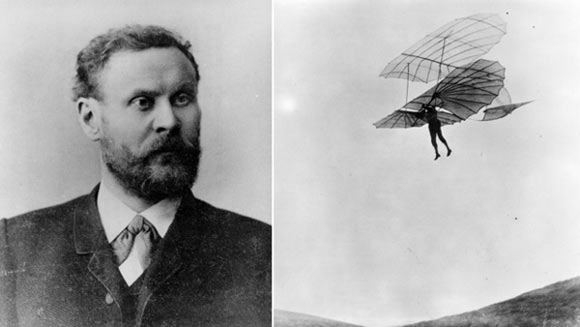
Otto Lilienthal in flight with one of his creations. Wikimedia
Wilbur began by exploring the books on the shelves of the family library that had anything to do with birds or flying. Once fully recovered from his illness, Orville proceeded with the same reading list. On 30th May, 1899 Wilbur was home alone when an idea came into his mind and he started writing a letter to the Smithsonian Institute in Washington, requesting all the material that had been published on the ‘problem of mechanical and human flight.’ With all the books and pamphlets on aviation forwarded to him, he and Orville both began reading in earnest. Especially helpful were the writings of Octave Chanute, a celebrated French-born American civil engineer and Samuel Pierpont Langley, an eminent astronomer.
In his letter to the Smithsonian, Wilbur had made mention of his interest in birds. He had taken up bird watching as a hobby. His observations of birds in flight had convinced him that birds used more “positive and energetic methods of regaining equilibrium” than that of a pilot trying to shift the center of gravity with his own body. For Wilbur and Orville the dream had taken hold. They would design and build their own experimental glider kite, drawing on much they had read, much they had observed about birds in flight, and, importantly, from considerable time thinking.
No bird soars in a calm
They had made themselves familiar with the language of aeronautics. Lift came from air moving faster over the arched top of a wing. Pitch was the lateral tilt of the flying machine, front and back, nose down, nose up. Roll applied to the rotation of the wing, up or down on one side or the other, like a boat rocking. Yaw applied to the direction of the flight, the turning of the plane pointing the nose left or right.
Equilibrium was the all-important factor, the brothers understood. The difficulty was not to get into the air but to stay there and for that the chief need was skill rather than machinery. It was impossible to fly without both knowledge and skill-of this Wilbur was already certain-and skill came only from experience-experience in the air. The brothers concluded that Lilienthal’s fatal problem was “his inability to properly balance his machine in the air.” Wilbur calculated that in all the time Lilienthal had given to gliders, he had only actually flown for about 5 hours in total and it was not nearly enough to master the skill of flying.
In the summer of 1899, in a room above their bicycle shop on West Third Street, the brothers began building their first aircraft, a flying kite made of split bamboo and paper with a wingspan of five feet. In early August Wilbur tested the model in an open field outside of town. The brothers felt the test had plainly demonstrated the efficiency of their system of control and that the time had come to begin work on a man-carrying glider.

The brothers moved the Wright Cycle Co. for the last time in 1897, to 1127 West Third Street. Here they built all their experimental aircraft, including the first powered airplane in 1903. Smithsonian Institution
On May 13, 1900, Wilbur wrote a letter to Octave Chanute-his first letter to the eminent engineer-asking for advice on a location where he might conduct flying experiments. The only such sites he knew of, Chanute replied, were in California and Florida, but both were “deficient in sand hills” for soft landings. In answer to an inquiry Wilbur sent to the United States Weather Bureau in Washington about prevailing winds around the country, he was provided with records of monthly wind velocities at more than hundred locations, enough for the brothers to take particular interest in a remote spot on the Outer Banks of North Carolina called Kitty Hawk, some seven hundred miles from Dayton.
To be certain Kitty Hawk was the right choice, Wilbur wrote to the head of the Weather Bureau station there, who answered reassuringly about steady winds and sand beaches. That decided the matter Kitty Hawk it would be. In the final weeks of August the brothers built a full-sized glider with two wings that they intended to reassemble and fly at Kitty Hawk, first as a kite, then if everything went well, fly themselves.
Wilbur left home on September 7 and reached Kitty Hawk on the 13th by boat. It was a hard journey to Kitty Hawk but he made it there nonetheless. He headed first to the home of William Tate, the former Kitty Hawk post master with whom he had corresponded. He allowed Wilbur to accommodate in his house while he did his work on the flyer. Until Orville arrived, Wilbur worked on setting up camp on a good sized hill half a mile from the Tate house , overlooking the water and also began preparing their glider. In a letter to his father Wilbur stressed that he was there to learn, not to take chances for thrills.
The man who wishes to keep at the problem long enough to really learn anything positively must not take dangerous risks. Carelessness and overconfidence are usually more dangerous than deliberately accepted risks
Orville joined Wilbur at the end of September and they started getting everything ready for experiments. With everything in place they began experiments on October 3rd. As word spread they were joined by the locals who watched them from a distance. Far from home, on their own in a way they had never been, the brothers seemed to sense as they never had the adventure of life.
The day was clear, the wind just as wished. It was October 19, and after nearly four years of concentrated study and efforts by the brothers, it proved a day of days. Wilbur made one manned flight after another. They had hoped to learn much of value there and they had, even more than expected. They packed for home certain they would return.
Work at the bicycle shop and the routines of family life at home continued for Wilbur and Orville much as usual over the next eight months, but nothing so occupied their free time and thoughts as did preparations for a return to Kitty Hawk. By mid-June of 1901, they were far enough along with their new machine to move up the departure to early July.
Wilbur wrote a lengthy report of his experiments to Octave Chanute who was so impressed that he decided to meet the brothers in person. To have a man of Octave Chanute’s standing come to call would be a high tribute. He was one of world’s leading authorities on aviation. He arrived in Dayton at 7 Hawthorn Street, where the brothers lived, on June 26. He brought a gift for the brothers, a portable French anemometer, by which they could measure wind speed accurately, something of great value they had been unable to do before.

The Wright family home at 7 Hawthorne Street, Dayton, Ohio. Library of Congress
Wilbur and Orville left Dayton together on their second expedition to Kitty Hawk on July 7, 1901. Octave Chanute sent two of his men, to join the brothers at Kitty Hawk and assist them. On July 27, with the glider at last ready, the experiments began. Wilbur was to do all the gliding. Expectations were high. But no sooner was the machine up than it nosed straight into the ground. Finally, after several more failed attempts he sailed off more than a 100 yards. The machine had not performed as expected, not, in fact, as well as the one the year before. To the brothers the machine was a disappointment.
They stopped gliding for several days to rebuild-flatten-the wings back to a camber close to what it had been in 1900, and with fine results. Work on the wings had filled the first week of August, during which Octave Chanute arrived. He was greatly impressed by what he saw. The successful tests flown with the reconstructed wings took place on August 8. Octave Chanute left kitty Hawk two days later, convinced the Wrights had made more progress and with a larger glider than anyone thus far, and urged them to keep on with their work. On August 20, Wilbur and Orville, too and others were on their way home.
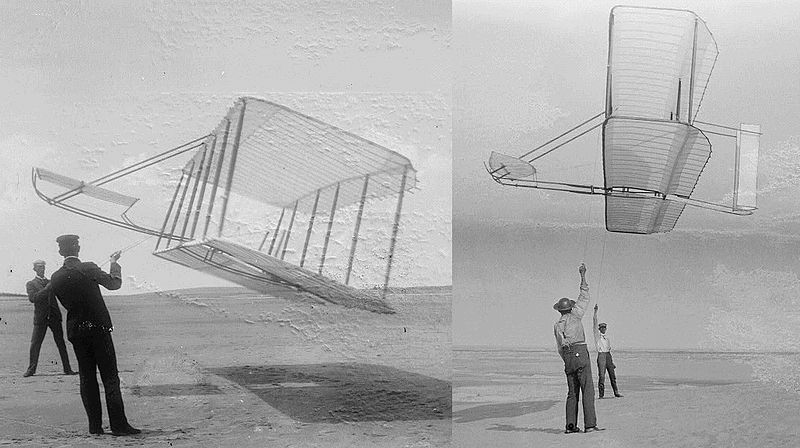
Wilbur and Orville wright flying their flyer of 1900(left) and 1901(right) as a kite. Library of Congress
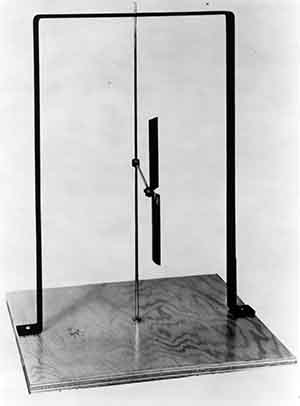
The photograph shows a reproduction of the Wrights' balancing vane in a wind tunnel. Smithsonian Institution
The pall of discouragement disappeared in a matter of days, replaced with a surge of characteristic resolve. They would make a fresh start. The brothers set out that autumn of 1901 to crack the code of aeronautics themselves. For three months, working in one of the upstairs rooms at the bicycle shop, they concentrated nearly all of their time on experiments, with a small scale wind tunnel powered by a gasoline engine, to find a way to achieve accurate measurements of the “lift” and “drag” of a wing’s surface. The ingenuity and patience they brought to their experiments yielded stunning results.
Never in the history of the world had men studied the problem with such scientific skill nor with such undaunted courage
By late December, their experiments finished and feeling the pressure of economic necessity, the brothers turned to the production of the next season’s bicycles. Not for another several months, until the spring of 1902, were they able to begin building a new glider based on all they had learned from the wind tunnel tests. By late August, the brothers had reached the final stage in building their new glider. On August 26 with everything needed for Machine No. 3 packed and crated for shipment, the brothers departed on their third expedition to Kitty Hawk.
The standard of living at Kitty Hawk had been greatly enhanced. Damage done to the camp by storms in their absence had required their immediate attention, but they also saw to considerably more. On September 8, they began working on the machine. It was by far the largest glider yet built and as Wilbur remarked, “an immense improvement over last year’s machine.” On September 19, they took it to a small hill and began flying it first as a kite and with “very satisfactory” results. After moving to larger hills in particular Kill Devil Hills, they made nearly fifty glides in three days-including manned flights-but cautiously. Even the longest flights were not much over 200 feet. Orville, too, was now gliding for the first time, and proudly so.
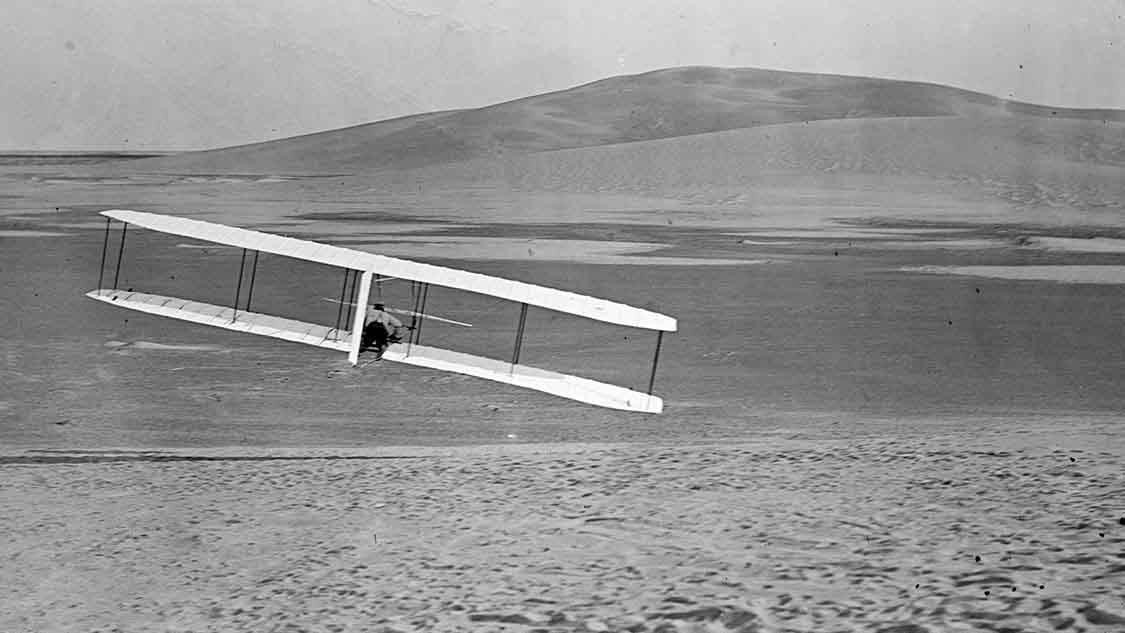
Wilbur making a right turn in glide from No.2 Hill, Kitty Hawk, North Carolina, 1902. Wrightbro
On October 2, after a long discussion in camp on aeronautical theory, Orville proposed a change to the rear rudder that instead of being fixed it should be movable for better control during flight. Work began on the change the next day. On October 17, the brothers started testing the remodeled glider. In ten days of practice they made more glides than in all the preceding weeks, and increased their record for distance to more than 600 feet. They broke camp at first light on October 28. They knew exactly the importance of what they had accomplished. They knew they had solved the problem of flight and more. They had acquired the knowledge and skill to fly. They could soar, they could float, they could dive and rise, circle and glide and land, all with assurance. Now they only had to build a motor.
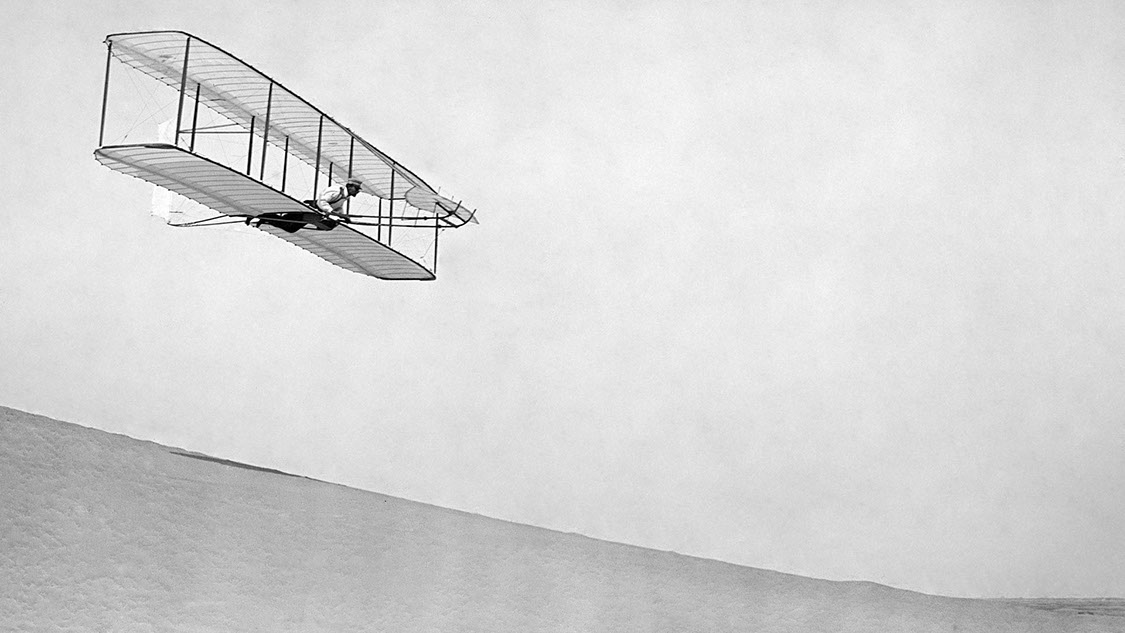
Wilbur Wright pilots a full-size glider down the steep slope of Big Kill Devil Hill in Kitty Hawk, North Carolina, 1902. This model was the third iteration of the Wright brothers' early gliders, equipped with wings that would warp to steer, a rear vertical rudder, and a forward elevator. Wrightbro
It was shortly before the New Year when the Wright brothers sent out letters to manufacturers of automobile engines in seven states asking if they could supply an off-the-shelf engine light enough in weight but with sufficient power for their purposes. There was only one response, and in that case the motor was much too heavy. So again they had some original work to do and they had had no experience building motors. To solve this problem they turned to the clever mechanic Charlie Taylor, whom they had put in charge of the bicycle business for some years because they couldn’t work on the flying machine and take care of business at the same time.
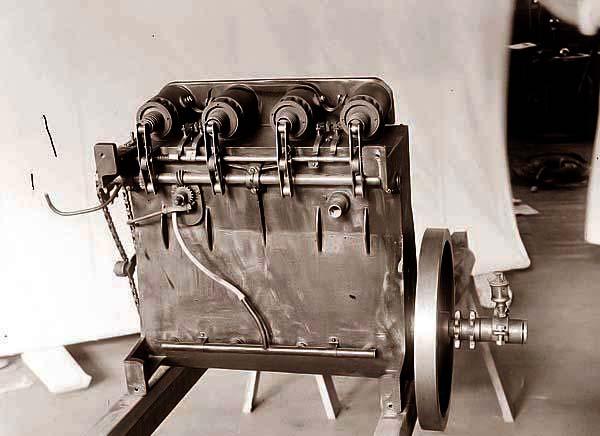
Charlie’s prior experience with a gasoline engine had been trying to repair one in an automobile a few years before. But that January, working in the back shop with the same metal lathe and drill press used for building bicycles, he went to work and six weeks later had it finished. The “little gas motor,” as Bishop Wright called it, was finished by mid-February, and when started up in the shop, the racket and clouds of smoke were nearly unbearable. It was several more months of work before the engine started working properly and it delivered an unexpected 12 horsepower.
Meanwhile, the design of the propellers had become a still bigger challenge. The problem became more complex the more the brothers studied it. Much to their surprise, they could find no existing data on air propellers. Once more they were left with no choice but to solve the problem themselves.
The thrust depends upon the speed and angle at which the blade strikes the air; the angle at which the blade strikes the air depends on the speed at which the propeller is turning, the speed the machine is travelling forward, and the speed at which the air is travelling backwards; the slip of the air backward depends on the thrust exerted by the propeller, and the amount of air acted upon. When any one of these changes, it changes all the rest, as they are all interdependent on one another
They realized that the only realistic way to test the efficiency of a propeller would be to try it out on the flying machine. The new flyer, as they called it, would have two propellers positioned between the two wings just to the rear of the operator. One would turn clockwise and the other would turn anticlockwise, so the spinning or gyroscopic action, of the one would balance that of the other. On March 23, the brothers applied for a patent on their flying machine, its wing-warping system, and rudder.
Work on their “whopper flying machine,” as they had come to call it, continued through the summer. The brothers and Charlie saw to the final touches on every component, every small detail, before departure for Kitty Hawk, where they knew, still more work would be required for the assembly of it all. By September 18, all was crated and on the train.
Once again at Kitty Hawk, the brothers proceeded on the flyer. By December 14th, all final preparations attended to, the brothers were ready. With the help of some men they hauled the 605-pound Flyer the quarter mile over to the Big Hill to the face of the slope where they had positioned a 60-foot launching track. Everything was set. There was no debate or extended discussion over which of them should go first. They simply flipped a coin. Wilbur won the toss and off he went but at the end of the track Wilbur made a mistake and the machine hit the sand a hundred feet from the end of the track.
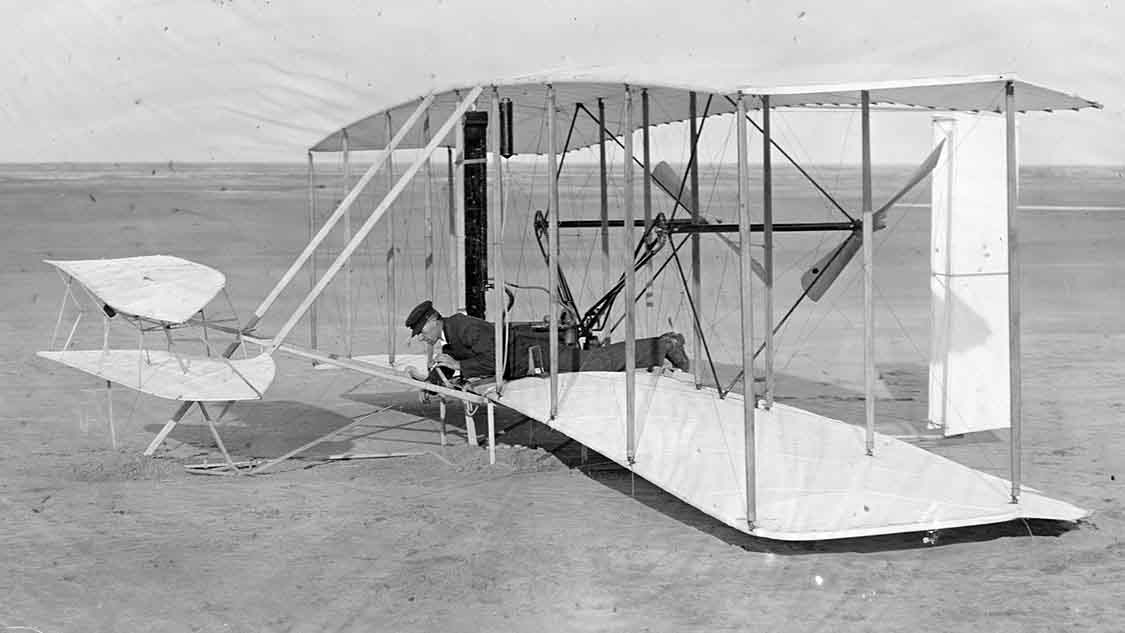
Wilbur Wright in damaged Flyer just after failed trial of December 14, 1903; Kitty Hawk, North Carolina. Wrightbro
The repairs took two days. Not until the afternoon of the 16th was the machine ready. The next morning with everything in place and ready to go, Wilbur and Orville walked off a short distance and stood close talking for some time. Because Wilbur had won the toss, three days ago it was now Orville’s turn. The two shook hands as if saying goodbye. At exactly 10: 35, Orville slipped the rope restraining the Flyer and it headed forward but not very fast, because of the fierce headwind. The course of the flight, in Orville’s words, was “extremely erratic.” The distance flown had been 120 feet, less than half the length of a football field. The total time airborne was approximately 12 seconds.

First flight: 120 feet in 12 seconds, on December 17, 1903. This photograph shows man's first powered, controlled, sustained flight. Orville Wright at the controls of the machine, lying prone on the lower wing with hips in the cradle which operated the wing-warping mechanism. Wilbur Wright running alongside to balance the machine, has just released his hold on the forward upright of the right wing. The starting rail, the wing-rest, a coil box, and other items needed for flight preparation are visible behind the machine. Orville Wright preset the camera and had John T. Daniels squeeze the rubber bulb, tripping the shutter. Wrightbro
At about eleven o’clock, the wind having eased off somewhat, Wilbur took a turn and “went off like a bird” for 175 feet. Orville went again, flying 200 feet. Then, near noon, on the fourth test, Wilbur flew a little over half a mile through the air and a distance of 852 feet over the ground in 59 seconds. It had taken four years. They had endured violent storms, accidents, one disappointment after another, public indifference or ridicule and much more. No matter. They had done it.
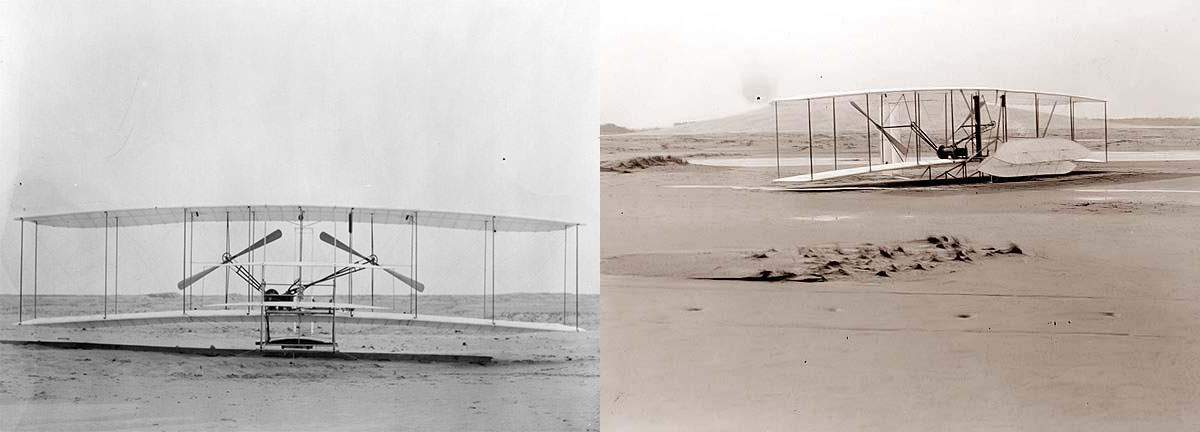
Wright Flyer I, built in 1903, front view(left) & side view(right). Wrightbro
Success it almost certainly was. And more. What had transpired that day in 1903, in the stiff winds and cold of the Outer Banks in less than two hours time, was one of the turning points in history, the beginning of change for the world far greater than any of those present could possibly have imagined. As they crated up the damaged Flyer to ship home, the brothers were “absolutely sure” in their own minds that they had mastered the problem of mechanical flying.
It wasn’t luck that made them fly; it was hard work and common sense; they put their whole heart and soul and all their energy into an idea and they had the faith
The reaction back in Dayton was disappointing. Nobody actually believed that the brothers had actually flown in their machine, or if they had, it could only have been a fluke. The brothers now intended to build a heavier version of the Flyer with a more powerful and efficient engine but they didn’t have enough money. To help cut expenses for continuing work on their flying machine, it was decided that further expeditions to Kitty Hawk could be dispensed with by finding a suitable stretch of open land close to home to serve as a practice field. The likeliest “flying field,” they concluded after some investigation, was a peaceful cow pasture northwest of town called Huffman Prairie.
The work to be done here, the brothers knew, could well be the final, critical stage in the maturation of their whole idea. Here they would have to learn to do far more than what they had at Kitty Hawk. They must master the art of launching themselves safely into the air, of banking and turning a motor-propelled machine, and landing safely. If space was limited then all the more need to make controlled turns. Meanwhile, in what time they had to themselves, the brothers were sawing and planning lumber for the ribs of the new machine and working with Charlie Taylor on the new motor.
Prior to their first test flight, lest anyone should think them overly secretive, the brothers invited friends and neighbors to come and watch. On May 26, 1904 the brothers decided to “make a start.” With Orville at the controls, Flyer 2 rose a mere 8 feet and came down at once, within seconds after leaving the starting track. Something had gone wrong with the motor. It was hardly a premiere to stir excitement or silence the doubters. After many attempts at last, on August 13, to their utter amazement, Wilbur flew over a thousand feet, farther than any of the flights at Kitty Hawk.
They still had problems with the takeoff because of lack of wind, something they had plentiful of at Kitty Hawk. The solution would have to be both simple and inexpensive, and so once again straightforward improvisation solved the problem. They designed and built their own “starting apparatus,” a catapult powered by nothing more than gravity. On September 7, with scarcely any wind, Wilbur tested the new catapult for the first time, he could take off with no difficulties and flew longer distances than ever. On September 20, 1904, Wilbur would attempt something never done before in the history of the world. He would fly a power machine in a complete circle. As for Huffman Prairie, it was henceforth historic ground.

Orville and Wilbur Wright with their second powered machine on Huffman Prairie, near Dayton, Ohio, in 1904. Wrightbro

Flight 19: Orville piloting, covering a distance of 356 feet, machine close to the ground; Huffman Prairie, Dayton, Ohio, 1904. Wrightbro
It was time the brothers let the world in on their achievements. They allowed a reporter, who met them at Huffman Prairie, to write articles about their flights. At the time his articles appeared in ‘Gleanings in Bee Culture’ but in January 1905 they were also published in 'Scientific American'. The American press or the U.S. government showed no interest but there were those on the other side of the Atlantic who did. An officer of the British Army appeared in Dayton on request of his government and asked the brothers to send a proposal for the sale of their Flyer 2 to the British government. The French were also beginning to make inquiries. As patriotic Americans they were unwilling to comply without their own country having the first chance but even after much effort by the brothers they couldn’t get the U.S. government interested so finally decided to make their proposal to the British.
As always, they had no time to waste. Work went on. A new Flyer 3 was under way in 1905, a machine “of practical utility,” as the Wrights would say. In fact, Flyer 3 would prove to be the first practical airplane in history. And there was more, always more to learn and think about. The new Flyer 3 would be more sturdily built than its predecessors, its motor more powerful, producing as much as 25 horsepower. Once the test flights got under way in June, it became clear the improvements were working. Moreover the two pilots were “rusty” no longer. Their Flyer 3, with its “improvements,” was as big an advance as Flyer 1 had proven to be at Kitty Hawk.
It was at Huffman Prairie that summer and fall of 1905 that the brothers, by experiment and change, truly learned to fly. Then, also, at last, with a plane they could rely on, they could permit themselves enjoyment in what they had achieved. They could take pleasure in the very experience of travelling through the air in a motor-powered machine as no one had. By now the brothers were openly encouraging family and friends to ride out and see the show. On the afternoon of October 5, 1905, before more than a dozen witnesses, Wilbur circled the pasture 29 times, landing only when his gas ran out. By the time the experiments ended, the brothers had made 105 “starts” at Huffman Prairie and thought it time now to put their creation, Flyer 3, on the market.

Flight 23: Orville Wright flying 2 circles of field at Huffman Prairie; 2 minutes, 45 seconds; Dayton, Ohio, September 1905. Wrightbro
By this point, too, the Dayton press had at last awakened. The Wrights, reported the Daily News, were making sensational flights every day as local witnesses were happy to attest. Prodded by Octave Chanute the brothers tried once more to rouse interest in Washington but the response was the same as before. Progress with the English having stalled, Wilbur informed an interested group in Paris that he and Orville were ready to discuss sale of the Flyer 3 to the French government.
Word was out that the “Wright boys” had made arrangements to sell their flying machine to the French. The year 1906 thus far had not been particularly promising for the brothers. They were sitting down with a French delegation that had come to talk seriously. The brothers refused to show the delegation their Flyer 3, but were willingly provided photographs and eyewitnesses’ testimony of the plane in flight. On May 22, 1906 the patent applied for in 1903 was at last issued on the Wright Flying Machine and the rest of the summer went on more test flights. The tempo of financial possibilities was picking up and many more offers were made in the upcoming months.
It was not until 1908 that the US Army and a syndicate of French businessmen each agreed to purchase Wright airplanes contingent upon their making demonstration flights. Wilbur first provided proof of their achievement at a racecourse near Le Mans, France. The sparse crowd was skeptical and growing impatient after waiting all day under the hot August sun. At six in the evening, Wilbur finally climbed aboard his machine. To the shock and amazement of everyone present, Wilbur not only flew, but also circled the field twice. A month later, Orville was making hour-long demonstration flights at Fort Myer near Washington, DC.
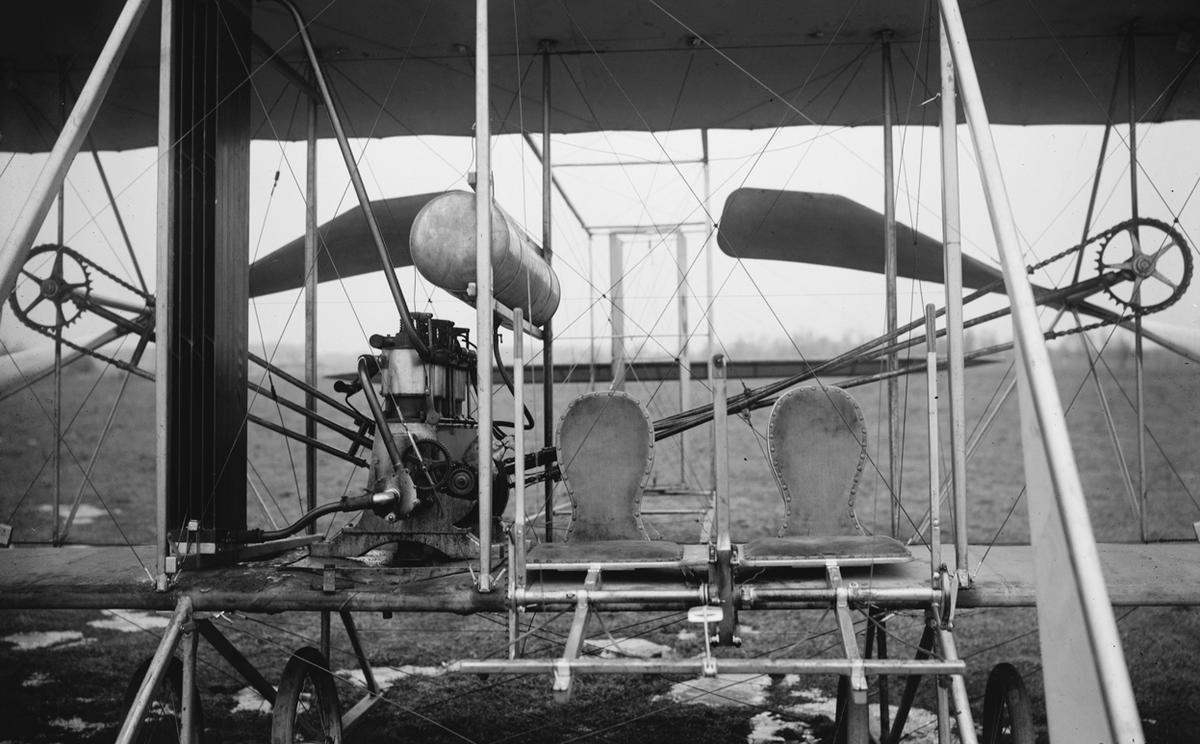
Close-up view of a Wright airplane, including the pilot and passenger seats. Library of Congress
On September 17, 1908 Orville took off with a young army officer, Lieutenant Thomas Selfridge, at his own request. The plane circled the field three times at 40 miles per hour but the fourth time, suddenly one of the blades of the right propeller cracked and the machine went out of control. Quick as a flash, the machine nosed down and headed straight for the ground from an altitude of 125 feet. It hit the ground with terrific force. Lieutenant Selfridge died and Orville’s condition was critical but he survived. It became the first casualty in the history of powered flight. Orville spent months in recovery at hospital and home. It was said that he would never properly walk again let alone fly. In less than a year’s time Orville was fully recovered and continued his demonstration flights at Fort Myer.
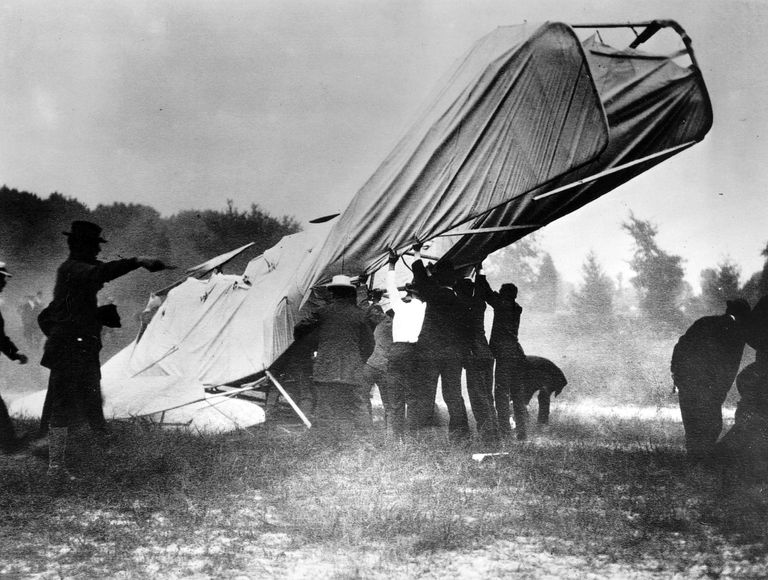
Troops of the U.S. Army Signal Corps rush to the site of a crashed plane to recover the pilot Orville Wright and his passenger, army observer Lieutenant Thomas E. Selfridge, from the wreckage on September 17, 1908, in Fort Myer, Virginia. Wikimedia
What came next was only celebration. The whole world celebrated and appreciated the achievement of the Wrights. It was an endless stream of going to parties being hosted in their honour, receiving medals and meeting people of elite class. The brothers had become the celebrities of the time. The French government had decided to confer the Legion of Honour upon both Orville and Wilbur. They were invited to Pau, France. At a reception for the Wrights put on by the mayor of Pau, some five hundred guests gathered in the Pau Garden. Nothing was talked about but mechanical flight. In the upcoming days there was a marked increase in notables from all over the world. Never in their lives had the wrights been among so many who, by all signs, had little to do but amuse themselves.
Surprisingly they didn’t feel out of place or the least intimidated by such company. They felt that, in their way, they were quite as well born and properly reared as anyone. Wilbur made his first flight at Pau on February 3, 1909 and from that day on remained a sensation. Most of Wilbur’s time was devoted to training the Comte de Lambert and another of the French aviators he was expected to teach. By now Wilbur was making flights with passengers five or six times a day. When a wealthy American from Philadelphia was told that only Wilbur decided who went with him, the man replied, “Oh, I dare say that can be arranged.” Others told him that they would like to be around when he does the arranging, just to see how it is done. The man didn’t get his ride. This alone shows who was in command.
King of Spain, Alfonso XIII arrived to witness “the miracle” and so did King of England, Edward VII. With their demonstrations concluded at Pau, the brothers packed a new Flyer, which had been built during their time in Pau, for shipment to Rome. During April, Wilbur completed more than fifty flights in Rome all without mishap. And again there was no shortage of prominent figures among the onlookers. King Victor Emmanuel III of Italy also paid a visit. The clamor and amazement over what the Wrights had achieved was by no means limited to Europe.
The Wrights were back in Dayton on May 13, 1909 and were welcomed by an enormous crowd. It was announced that the Aero Club of America would present the brothers with a gold medal and Congress, too, had voted a medal to be presented by President William Howard Taft, and Dayton was making preparations for the biggest celebration in its history. In June the brothers went to Washington and Orville continued his demonstrations at Fort Myer that he had to abandon the year before due to the crash. On July 27, Orville took off with Lieutenant Frank Lahm as a passenger on an official endurance trial that lasted for an hour and 12 minutes breaking a world record that Wilbur had set at Le Mans. An estimated eight thousand spectators, saw him took off and among them was President Taft. Their contract with the War department would be signed.

Orville Wright during proving flights for the U.S. Army at Fort Myer, Virginia, in July of 1909. The Wright brothers were able to sell their airplane to the Army's Aeronautical Division, U.S. Signal Corps. Library of Congress
A Wright Company for the manufacture of airplanes was incorporated, with offices on Fifth Avenue in New York. On May, 1910, the brothers invited family, friends, neighbors and anyone interested, to come to Huffman Prairie to see Orville fly. In all the years they had been working together Wilbur and Orville had never once flown together, so if something were to go wrong and one of them should be killed, the other would live to carry on with the work. But on this day at Huffman Prairie, the two of them seated side by side, took off into the air with Orville at the controls.
Many years earlier, there was a young Orville Wright in a grade school, who was tinkering with bits of wood. When asked by his teacher what he was up to, he told her he was making a machine of a kind that he and his brother were going to fly someday.


